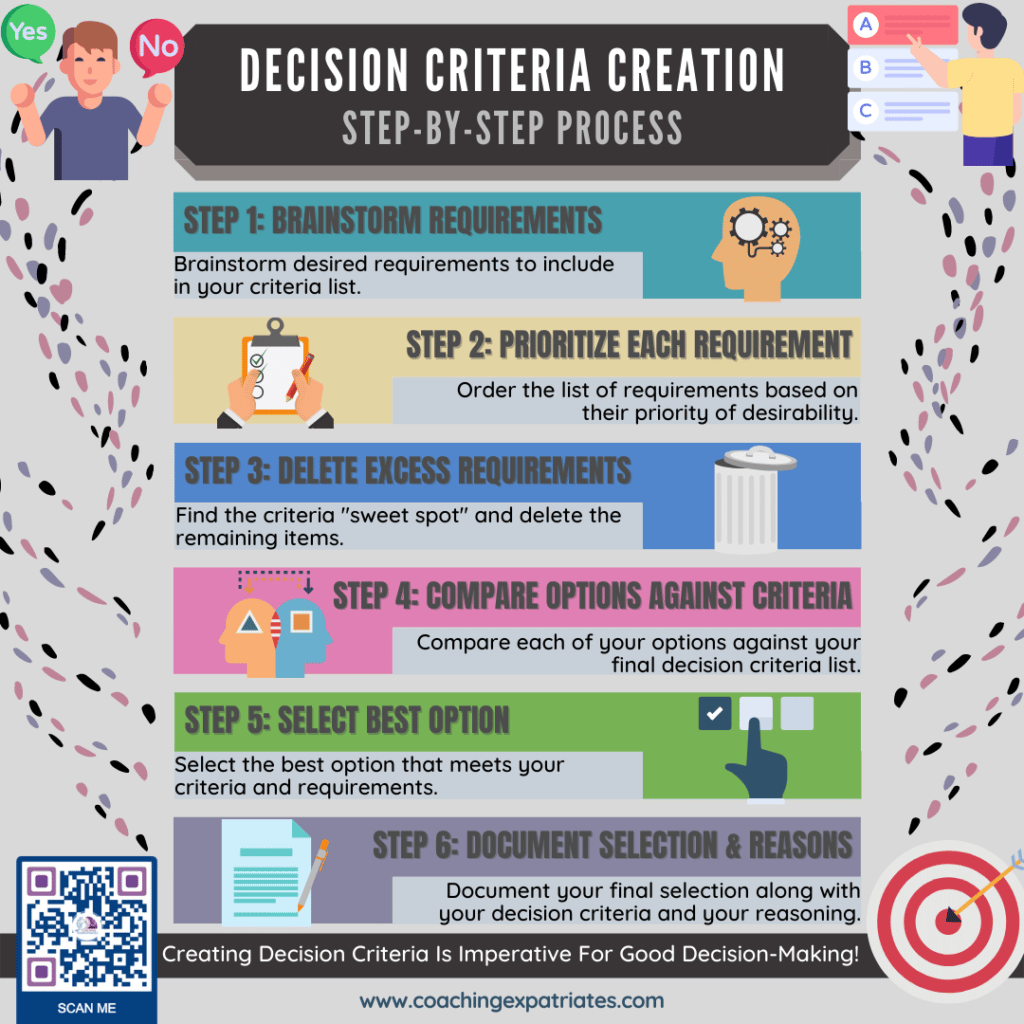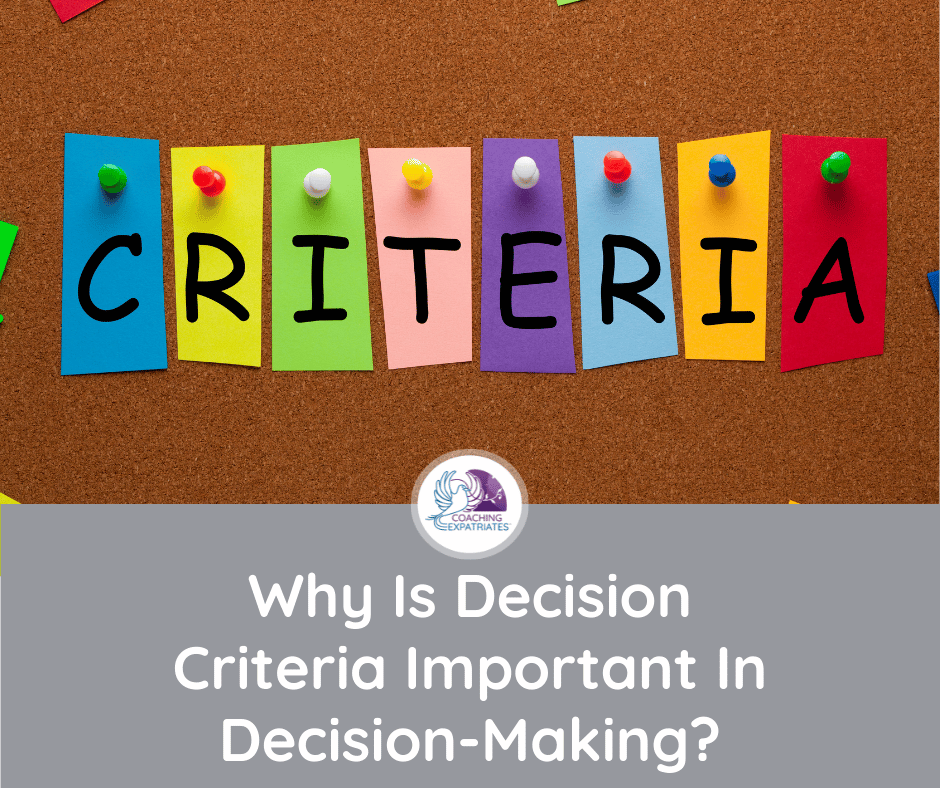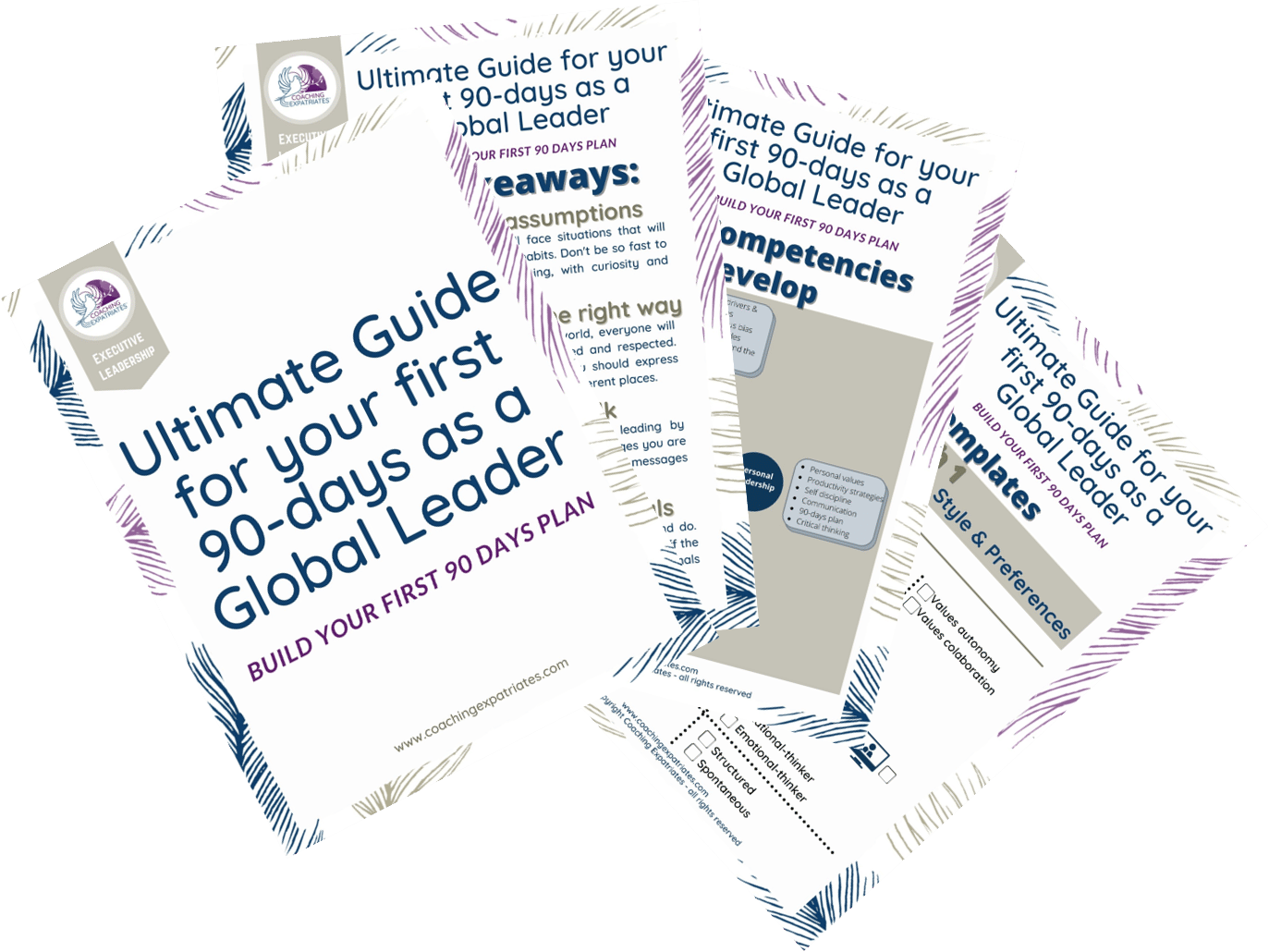A lot of people have a really hard time making important decisions. One of the reasons this is so is that they never understood the importance of including decision criteria in their decision-making process.
In today’s post, I want to cover all critical aspects of decision criteria to help you make better and more impactful decisions.
What Is Decision Criteria?
Whenever you are about to make a decision, you frequently have options to choose from. Selecting the best option is the act of making the final decision. But how do you decide between the options? One way is to use decision criteria to help you in your analysis. Decision criteria are a set of guidelines and requirements used when analyzing options to make a decision.
In a nutshell, decision criteria are the “filters” you will use in your decision-making process to rule out options that don’t meet the needed requirements.
Decision criteria are very used in procurement departments, where a selection of a provider needs to be well documented and justified. A decision criterion has not only the power to help you make the best choices for your use case, but also helps you in documenting your choices and reasons. This reduces uncertainty and chances of regretting your selections later.
This is one of the reasons why having decision criteria is a must in most organizations. So learning about it is essential for any global executive and employee.
How Decision Criteria Help Organizations And Why Are They Important?
Besides helping in making the best selection of choices, here are a few things decision criteria can help with:
1- Selection Of Best Choice.
As we said, it helps you drill down on what you want and need, and then rule out finalists or a single final choice based on your requirements.
2- Well-Established Definition Of Success Measures.
By defining specific decision criteria, you automatically define the success measures for your choices. This will help you evaluate performance later on.
3- Communication Efforts.
Having a set of requirements and guidelines defining the decision process makes it easier to communicate what the defining rules and requirements are across all decision-makers. You can even create a template per vendor or option comparing the criteria against the choice to help decision-makers have a quick overview of each option visually.
4- Documentation.
Once you have well-defined decision criteria, it becomes easier to compare each option against the criteria and document what you will do based on the comparison. For example, let’s say you define in the criteria a budget cap of $10 per unit. All vendors who offered at $11 can be ruled out and documented as ruled out by this criterion.
5- Aligned approval process.
Decision criteria help with alignment and assertiveness. Once you have the criteria and comparison for all choices, it’s impossible to say that you should select an option that was ruled out without a very good reason. If the decision criteria were well established initially, decision-makers wouldn’t argue about ruling out what the requirements specified. This allows alignment and consistency.
6- Compliance.
In countries with high corruption perception index, having well-identified criteria help keep your selections in check, with compliance and transparency of decision-making.
3 Different Dimensions Of Decision Criteria
One can define the basic dimensions of decision criteria into 3 different types:
Technical Decision Criteria
That is focused on meeting technical requirements for a solution.
Economic Decision Criteria
That is focused on meeting cost, budget, return on investment, and risk requirements for a solution.
Relationship Decision Criteria
That is focused on how aligned the value-proposition and purpose are with a solution’s requirements.
When working with GE Aviation, their selection criteria were highly rigorous. Their criteria always had elements from all these 3 dimensions.
Although it is not necessary to touch upon all 3 dimensions above to have good criteria, you should always explore the possibility of having all of them while creating your decision criteria.
How To Create A Decision Criteria
First and foremost, it is essential to note that the number of elements in the decision criteria will define how difficult or how easy it will become to make a selection. If you have very few or too many elements, it will become difficult to select.
The “filters” the criteria provide might not filter enough when you have a few elements. For example, let’s say you are buying a rug. If you include in your criteria – or filters – that it must be round and less than $20, you’ll get too many options to choose from.
However, if you include too many filters, like blue, round, machine-wash, outdoor, 5” x 5”, water-resistant, dust-resistant, Persian, less than $20, delivery for tomorrow, and made in the USA. Maybe you’ll come with zero options once you include all these filters.
In other words, this is to say that there is always a sweet spot for how many items your decision criteria should include. Too many elements and too few are not recommended.
Decision Criteria Creation: Step-By-Step Process
So how can you create decision criteria? Below you can see a suggested step-by-step process that I use when creating my own decision criteria:
Step 1: Brainstorm Desires.
Brainstorm elements of desire related to your decision. You can see the list below to get you started with some ideas. Be specific for each of your desires. For example, let’s say you are buying a car. What’s the cost range? Which are the safety features? Is it a working car that will provide you with a return on investment, if yes, how much? And so on.
Step 2: Prioritize.
Now that you got a list of things you want from your selected option or decision, put them in order of importance. Your top one is the most important requirement or criterion. Second is the second most important one, and so on.
Step 3: Delete Elements.
Now that you have your list of priorities, delete the ones from the bottom until you have 5 or 6 main items for your criteria. Once you get more experienced with that decision, you will quickly know if 5 or 6 is in the “sweet spot” we mentioned before.
Step 4: Compare options.
Compare all your potential decision options against your final criteria defined in step 3. This comparison or analysis can be made in many ways, like using Decision Matrix Analysis, Weighing analysis, Pro & Cons analysis, and so on. The most common analysis method paired with decision criteria is the Decision Matrix.
Step 5: Make your choice.
Now that you made comparisons, you were able to rule out most of the choices and either get to one choice or fewer choices. Now it will be time to make a more qualitative and subjective decision between the few options left.
Step 6: Document Choices And Reasons.
Document your choice with the data, criteria, and rationale used for the selection. The more detailed you are in this step, the more context and reference you’ll give yourself in the future when you have to revisit this decision. It is also helpful during audits and when some level of regret is involved. If that happens, you can return to your documentation and remember that you made a detailed analysis to make this decision. If you have it all documented, you’ll learn much more in the process.
One thing to note is that in Step 4, once you use your “filters” or criteria to see which choices are left to compare, the number of elements in step 3 is optimum, when in step 4 you get only a handful of options left.
For example, let’s say in Step 3 you got 5 decision criteria. And this helped you see in step 4 that this gets you 10 options out of 50. If you go back to step 3 and include one 6th element or criterion, you then get only 5 options instead. You will then know your “sweet spot” is closer to 6 elements than to 5. The inverse could be true. So don’t be ashamed of doing this back-and-forth until you find your sweet spot. That’s why step 2 – prioritizing elements – is vital.
The main decision-makers should do this step-by-step exercise. In my experience, if you don’t include all pertinent decision-makers in this exercise, you are inviting conflict and issues during steps 4 and 5. You don’t want that. You want a smooth, easy, and fast decision-making process. So make sure to include relevant decision-makers. Too many decision-makers can be a red flag for efficiency. So be smart about who you invite for the decision-making process.

Examples Of Decision Criteria
I selected some of the important criteria normally used during many business decisions to help you take a step further into using decision criteria for better decisions.
1. Financial Criteria
- Cost
- ROI – Return on investment
- Budget cap
- Risk levels
- Opportunity cost
- Terms and conditions
2. Supply Chain Criteria
- Time and deadlines
- Quality
- Performance
- Efficiency
- Reliability
- Longevity
- Resilience
- Sustainability
- Minimum quantities
- Easiness doing business
3. Product Attractiveness Criteria
- Functions
- Features
- Benefits
- Style
- Convenience
- Comfort
- Usability
- Customer experience
4. Production Line Criteria
- Ease of deployment or implementation
- Ease of accessibility to raw materials
- How fast is the learning curve
- Ease of transportation and storing
There you go, global leader! Now you have a step-by-step process to create your very own decision criteria and kick-ass while making impactful business decisions!
If you are interested in developing your business acumen for better decision-making and want to learn all the important skills that every high global executive has, check out our online Global Executive Leadership Program. We go over all 4 success pillars of Global Leadership during 9 online modules, including 2 dedicated modules in Organizational Leadership that help improve business acumen.
In case you have a specific Skill in mind that you want to develop or a situation in which you feel stuck, you can purchase one of our executive coaching packages. We can help you sort the issue or topic out during your program and find the best course of action to make things better for you and your team. Executive coaching can be an extremely powerful tool for building skills to make impactful business decisions, and many high executives make constant use of it.
If you enjoyed this post, consider subscribing to our newsletter using the form below. We focus on providing good content to global leaders and executives who want to make impactful business decisions and be more inclusive and influential. We know your inbox is sacred, so we email just once per week, and we never sell your information. Trust is the basis of Global Leadership, and we fully honor it.







